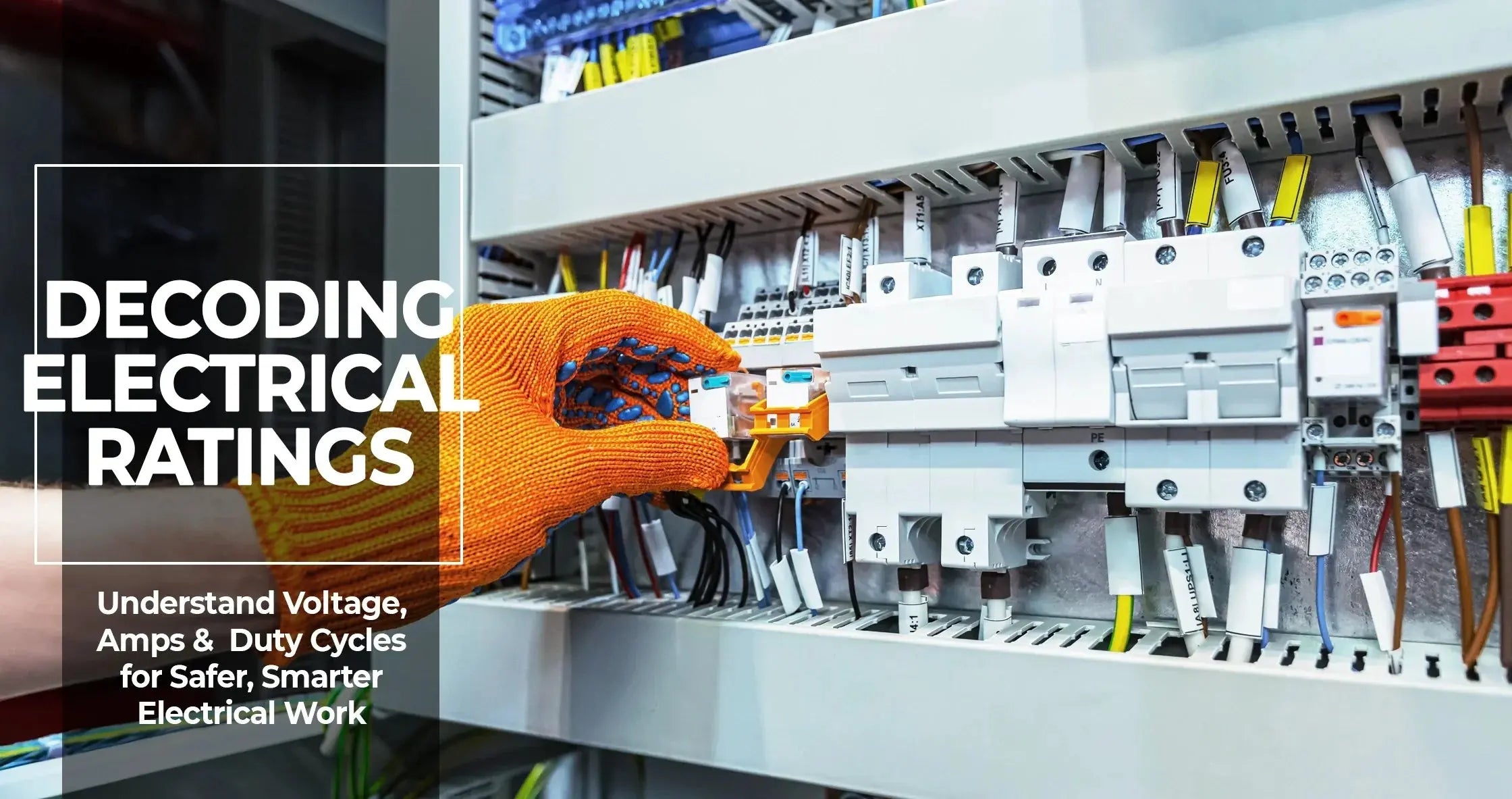When it comes to electrical systems, understanding electrical ratings is not just useful—it’s essential. Whether you're an electrician, engineer, or DIY enthusiast, these ratings provide vital information about how electrical equipment performs under certain conditions. In this guide, we’ll break down the fundamental components of electrical ratings, including voltage, current (amps), and duty cycles, to help you make informed and safe decisions when working with electrical systems.
What Are Electrical Ratings?
Electrical ratings are standardized values that describe the operating limits and capabilities of electrical devices. These ratings help users understand how much voltage a device can handle, how much current it can carry, and how long it can operate safely under specific conditions.
Manufacturers define these ratings based on rigorous testing to ensure safety and performance. Ignoring them can lead to overheating, equipment failure, or even electrical fires. That’s why understanding electrical ratings is critical, whether you're selecting a power tool, sizing a circuit breaker, or installing industrial machinery.
The Importance of Electrical Ratings
The primary purpose of electrical ratings is to ensure safety and reliability. They are the backbone of effective electrical design and maintenance. Here are a few key reasons why understanding electrical ratings matters:
-
Prevents Equipment Damage: Overloading devices beyond their ratings can lead to permanent damage or degraded performance.
-
Ensures Safety: Improper electrical setups can cause shocks, fires, or short circuits.
-
Compliance with Standards: Regulatory bodies often require compliance with specific ratings for residential, commercial, and industrial applications.
Understanding electrical ratings also helps with equipment compatibility. Plugging a 120V-rated appliance into a 240V outlet, for example, can be catastrophic. Conversely, underpowering a device can cause it to malfunction or not operate at all.
Electrical Ratings: Voltage Explained
Voltage is the potential difference that drives electric current through a circuit. It is measured in volts (V) and is one of the most fundamental aspects of electrical ratings.
Every device is designed to operate within a specific voltage range. For instance:
-
Household appliances in the U.S. are typically rated for 120V.
-
Heavy-duty industrial equipment may require 240V, 480V, or even higher voltages.
Exceeding the voltage rating of a device can result in overheating, insulation breakdown, and failure of electronic components.
Common Voltage Ratings and Their Applications
| Voltage Rating | Common Use Case |
|---|---|
| 12V or 24V | Automotive, LED lighting |
| 120V | Standard home appliances |
| 240V | Electric dryers, ovens |
| 480V+ | Industrial motors, machinery |
Knowing the voltage rating is essential for proper installation and operation. Always match the voltage rating of the equipment with the power source.
Electrical Ratings: Current (Amperage) Defined
Current, measured in amperes (amps), refers to the flow of electrical charge. It’s another critical component of electrical ratings, especially when dealing with wires, circuit breakers, and connectors.
If a device draws more current than the circuit can handle, the wiring may overheat, potentially causing fires. That’s why all electrical systems are rated for a maximum current.
Amps vs. Watts: What’s the Difference?
While amps measure current, watts measure power. Power is calculated by multiplying voltage by current:
Power (Watts) = Voltage (Volts) x Current (Amps)
Understanding the amperage rating is essential for:
-
Sizing circuit breakers and fuses
-
Determining wire gauge requirements
-
Avoiding overloads and short circuits
Duty Cycles in Electrical Ratings
The duty cycle of an electrical device refers to the amount of time it can operate at a given load without overheating. It is usually expressed as a percentage. For example, a 50% duty cycle means a device can operate for 5 minutes in a 10-minute cycle.
This is particularly relevant for tools and machines that generate heat during operation. If you exceed the duty cycle, the equipment could overheat or wear out prematurely.
Examples of Duty Cycles
-
100% Duty Cycle: Continuous operation (e.g., fans, some industrial motors)
-
50% Duty Cycle: Welders, certain compressors
-
25% Duty Cycle: High-power tools used intermittently
Understanding duty cycles helps ensure you choose equipment that matches your application needs.
How to Read an Electrical Rating Label
Most electrical devices come with a label or nameplate indicating their ratings. Here’s how to interpret a typical label:
Example Label:
-
Voltage: 120V
-
Current: 10A
-
Frequency: 60Hz
-
Power: 1200W
-
Duty Cycle: 50%
Each of these figures provides critical insight into how the device should be used. Always check this label before installation or use.
Factors Affecting Electrical Ratings
Several variables can influence how electrical ratings are determined or how they should be interpreted:
-
Ambient Temperature: Ratings often assume a standard temperature. Higher ambient temperatures may reduce a device’s capacity.
-
Altitude: Higher altitudes can affect cooling and insulation performance.
-
Installation Method: Enclosed vs. open-air installation can change how much heat dissipates.
-
Load Type: Resistive vs. inductive loads affect performance and current draw.
Understanding these variables ensures you apply electrical ratings correctly under real-world conditions.
NEMA and IP Ratings: Environmental Protection Standards
Besides voltage and current, electrical ratings also include environmental protection standards like NEMA and IP ratings:
-
NEMA Ratings (U.S.): Define the enclosure's ability to resist environmental hazards like dust, water, and corrosion.
-
IP Ratings (International): Use a two-digit code to indicate levels of protection against solids and liquids.
For instance:
-
NEMA 4X = Corrosion-resistant and watertight
-
IP67 = Dust-tight and protected against immersion in water
Choosing the correct enclosure rating protects your equipment and enhances safety.
Regulatory and Safety Considerations
Compliance with electrical ratings is mandated by regulatory agencies such as:
-
UL (Underwriters Laboratories)
-
CE (Conformité Européenne)
-
IEC (International Electrotechnical Commission)
Each of these standards helps ensure devices meet minimum safety requirements. Failing to adhere to rated guidelines may void warranties or insurance coverage and could result in legal liabilities.
Real-World Applications of Electrical Ratings
Let’s consider how electrical ratings affect real-world scenarios:
Home Renovations
When upgrading your home’s electrical panel, understanding electrical ratings ensures that new breakers and appliances are compatible and safe.
Industrial Machinery
Large motors must be rated accurately for both voltage and amperage. Using underrated equipment can cause costly downtime and equipment failure.
Renewable Energy Systems
Solar inverters and batteries come with specific voltage and current ratings. Correct sizing prevents underperformance or failure of the system.
How to Determine the Right Electrical Ratings
To determine the right electrical ratings for your needs:
-
Review Equipment Specifications: Always read the manufacturer’s datasheet.
-
Assess Operating Environment: Consider temperature, humidity, and exposure to dust or water.
-
Calculate Load Requirements: Determine the total load in watts, then convert to amps using your system voltage.
-
Account for Duty Cycles: Choose equipment rated for your expected run-time needs.
Mistakes to Avoid When Evaluating Electrical Ratings
Here are common mistakes that can lead to equipment failure or safety issues:
-
Using extension cords with inadequate amp ratings
-
Connecting 120V appliances to 240V sources
-
Overlooking duty cycles in motorized equipment
-
Ignoring environmental protection ratings
Avoiding these mistakes ensures a longer lifespan for your equipment and prevents dangerous situations.
Final Thoughts on Electrical Ratings
Whether you’re designing a system from scratch or maintaining existing equipment, a clear understanding of electrical ratings is non-negotiable. Voltage, current, and duty cycles are not just numbers—they are critical guidelines for performance and safety.
Incorporating these concepts into your daily electrical work helps you stay compliant, prevent malfunctions, and ensure the longevity of your devices. Next time you see a rating label, you’ll know exactly what it means and why it matters.
Key Takeaways:
-
Electrical ratings define the safe operating conditions for a device.
-
Voltage and current must be matched correctly to the power source.
-
Duty cycles determine how long a device can run before needing rest.
-
Environmental and safety ratings (like NEMA/IP) protect against external hazards.
-
Always refer to specifications and use appropriate tools when working with electricity.
For more in-depth guides on electrical topics, keep exploring our blog. Your safety and efficiency depend on understanding the ratings behind the power.


